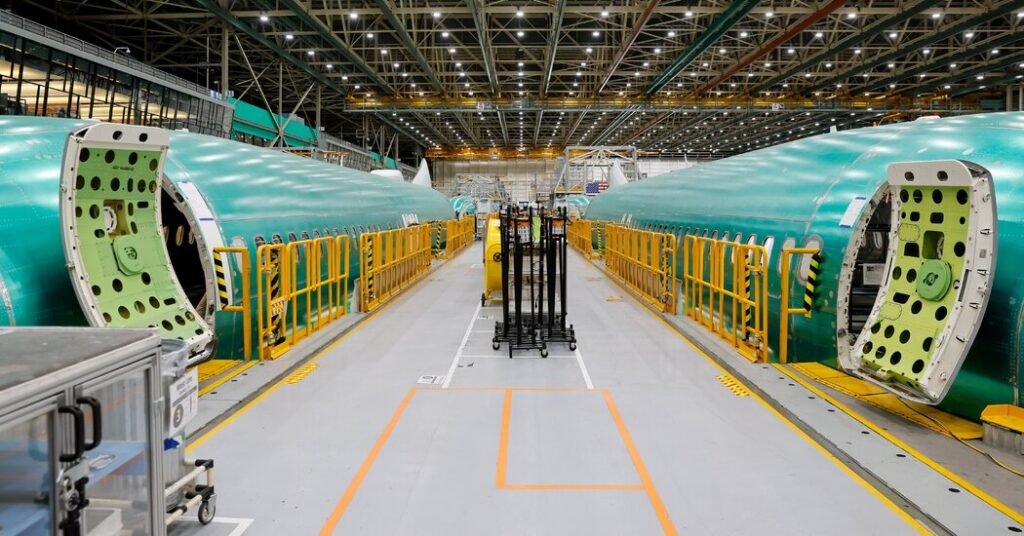Boeing says it has achieved significant quality improvements in the production of the 737 Max since one of the planes lost a panel in a harrowing flight in January.
The incident, on an Alaska Airlines flight, resulted in no major injuries, but it raised fresh concerns about the quality of Boeing’s planes more than five years after two fatal crashes. In response, Boeing announced changes aimed at improving quality and safety, including expanding training, simplifying plans and procedures and reducing defects from suppliers.
Speaking to reporters this week at the company’s factory in Renton, Wash., a Boeing executive, Elizabeth Lund, also provided new detail about how the 737 Max left the plant missing four critical bolts that secured the panel, known as a door plug, in place.
One of the more important changes Boeing has made since January was requiring that bodies of 737 Max planes pass a more rigorous inspection before being shipped to Renton, near Seattle, for final assembly. The body is made in Wichita, Kan., by Spirit AeroSystems, a supplier that Boeing is expected to soon acquire.
That change took effect a few months ago and has resulted in significantly fewer major defects that need to be fixed at Boeing’s factory, said Ms. Lund, the senior vice president for quality in Boeing’s commercial airplane division. The supplier inspections have also allowed Boeing to make the Max more quickly once the bodies arrive at its factory. The company is also producing fewer planes than planned because the Federal Aviation Administration limited its production rate after the January flight.
“We’ve strengthened our presence at the supplier, we ensure the parts are perfect where they ship, we inspect them there, they rework them there, and then we ship the parts,” Ms. Lund said. “The benefits have been really tremendous.”
The January incident was a new blow to Boeing’s reputation after two crashes of Max 8 planes in 2018 and 2019, in which 346 people died. The crashes led to a global ban on the Max that lasted about 20 months; the plane started flying again in late 2020.
For years after the crashes, Boeing’s executives assured regulators, airlines and the public that they had made sweeping changes to improve the quality and safety of its planes. But the January incident — and accounts from current and former employees about shoddy work and poor management decisions, as reported by The New York Times and others — suggested that the changes it had made then had not gone far enough.
Ms. Lund said that the earlier Max crisis had forced Boeing to reform its engineering practices, but that the more recent incident had required improvements to the production process.
“When this accident came along, it gave us a chance to look at a different area,” she said.
When the body of the plane involved in the January flight arrived at Boeing’s factory in the summer of 2023, five rivets did not meet specifications. As the plane worked its way through the factory, Boeing and Spirit discussed how to address the problem. By the time they decided that the rivets needed to be replaced, work on the plane was nearing completion.
Ms. Lund described what followed: The panel was removed to fix the nearby rivets, but no one documented that removal. Later, a team prepared the aircraft to be moved outside, closing the panel. Because there was no paper trail, employees were unaware that they needed to replace the four bolts that had secured the door. The panel, which fits snugly into the gap it covered, survived about 500 hours in flight before blowing out at an altitude of about 16,000 feet.
The National Transportation Safety Board, which is investigating the incident, has criticized Boeing for not properly documenting the door plug removal.
The Federal Aviation Administration, which is Boeing’s main regulator, has also demanded that the company make big changes to improve quality.
Other improvements the company has made, Ms. Lund said, include more training for new hires before they start working on planes and expanded on-the-job training. The company dispatched more than 160 workplace coaches, including veteran and retired mechanics, to help newer workers get up to speed.
The company is also accelerating efforts to simplify an array of plans and procedures, Ms. Lund said. Boeing has increased inspections and internal monitoring and placed renewed emphasis on encouraging workers to speak up about concerns, collecting thousands of new comments and recommendations on improving quality.
Boeing has also been trying to reduce work performed out of sequence, known as traveled work, which can increase the risk of mistakes and cause other problems. The company said it had imposed more stringent requirements that had to be met before planes could advance down the production line. That and other changes have helped the company cut the amount of traveled work back by more than 50 percent, Ms. Lund said.


